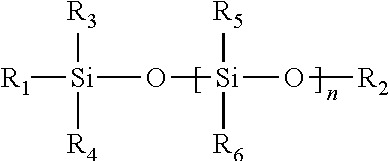Modifier for polyester fiber as well as preparation method and application of the same
a technology of polyester fiber and modifier, which is applied in the field of modifier for modifying polyester fiber, can solve the problems of poor hygroscopicity, decontamination properties, and bulky and soft properties of polyester fiber, and achieves the effects of improving the effect of modifying polyester fiber, improving comfortability of fabric, and good hand feeling
- Summary
- Abstract
- Description
- Claims
- Application Information
AI Technical Summary
Benefits of technology
Problems solved by technology
Method used
Image
Examples
example 1
[0028]1) The following materials are weighed as required: 800 g polyglycol with a molecular weight of 10000˜20000 (a compound with a general formula of H(OCH2CH2)mOH), 150 g ethylene glycol, 150 g polyether dihydric alcohol with a molecular weight of 1000˜5000 (a compound with a general formula of H(OCH2CH(CH3))nOH), 80 g two-polyether-end organosilicon, 180 g dimethyl terephthalate, and 5 g catalyst of magnesium acetate;
[0029]2) polyglycol, ethylene glycol, and polyether polyhydric alcohol are added into the reactor, which is then heated; the reactor is vacuum-pumped when its temperature rises to 75°, making vacuum degree inside the reactor up to −0.090 Mpa; then the reactor is heated further to 90° until the materials inside are dehydrated completely; the reactor is heated to 102°; dimethyl terephthalate, two-polyether-end organosilicon and magnesium acetate are added into the reactor, which is then heated further to 150°; the materials in the reactor are pressed into the polymeri...
example 2
[0030]1) The following materials are weighed as required: 900 g polyglycol with a molecular weight of 4000˜8000 (a compound with a general formula of H(OCH2CH2)mOH), 120 g ethylene glycol, 120 g polyether dihydric alcohol with a molecular weight of 11000˜15000 (a compound with a general formula of H(OCH2CH(CH3))nOH), 200 g two-polyether-end organosilicon, 165 g dimethyl terephthalate, and 5 g calcium acetate;
[0031]2) polyglycol, ethylene glycol, and polyether polyhydric alcohol are added into the reactor, which is then heated; the reactor is vacuum-pumped when its temperature rises to 78°, making vacuum degree inside the reactor up to −0.093 Mpa; then the reactor is heated further to 95° and, after being kept at the temperature for 55 minutes, further to 104°; dimethyl terephthalate, two-polyether-end organosilicon and calcium acetate are added into the reactor, which is then heated further to 155°; the reactor is kept at this temperature for 75 minutes to make the materials in the ...
example 3
[0032]1) The following materials are weighed as required: 1000 g polyglycol with a molecular weight of 1000˜5000 (a compound with a general formula of H(OCH2CH2)mOH), 100 g ethylene glycol, 100 g block polyether of ethylene glycol and propylene glycol with a molecular weight of 5000˜9000 (an atactic copolymer with a general formula of H(OCH2CH2)p(OCH2CH(CH3))qOH), 150 g two-polyether-end organosilicon, 150 g dimethyl terephthalate, and 10 g zinc acetate;
[0033]2) polyglycol, ethylene glycol, and the block polyether of ethylene glycol and propylene glycol are added into the reactor, which is then heated; the reactor is vacuum-pumped when its temperature rises to 80°, making vacuum degree inside the reactor up to −0.095 Mpa; then the reactor is heated further to 100° and, after being kept at the temperature for 60 minutes, further to 106°; dimethyl terephthalate, two-polyether-end organosilicon and zinc acetate are added into the reactor, which is then heated further to 160° to make th...
PUM
| Property | Measurement | Unit |
|---|---|---|
| Fraction | aaaaa | aaaaa |
| Fraction | aaaaa | aaaaa |
| Fraction | aaaaa | aaaaa |
Abstract
Description
Claims
Application Information
 Login to View More
Login to View More - R&D
- Intellectual Property
- Life Sciences
- Materials
- Tech Scout
- Unparalleled Data Quality
- Higher Quality Content
- 60% Fewer Hallucinations
Browse by: Latest US Patents, China's latest patents, Technical Efficacy Thesaurus, Application Domain, Technology Topic, Popular Technical Reports.
© 2025 PatSnap. All rights reserved.Legal|Privacy policy|Modern Slavery Act Transparency Statement|Sitemap|About US| Contact US: help@patsnap.com



